The iPhone 12 & 12 Pro Review: New Design and Diminishing Returns
by Andrei Frumusanu on November 30, 2020 8:30 AM EST- Posted in
- Mobile
- Apple
- Smartphones
- Apple A14
- iPhone 12
- iPhone 12 Pro
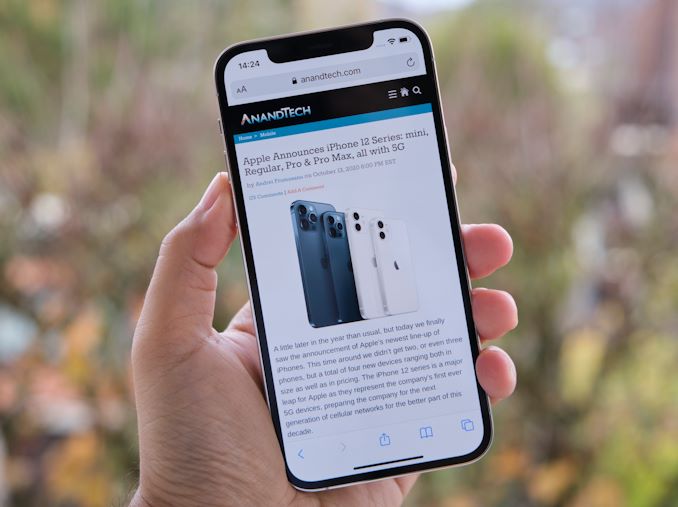
The new iPhone 12’s have been out for a while now, and while we’ve had our hands on them for a few weeks, Apple’s news bombardment of the new Apple Silicon announcement and release of new Apple M1 Mac devices has meant the iPhones have had to be put on the back burner for a little while.
Having already covered Apple’s new A14 architecture in-depth in our coverage of the M1, it’s time to fill in the missing pieces for the actual new generation of iPhones.
The new iPhone 12 generation of devices mark a new design restart for Apple, moving away from the design that had been started with the iPhone X in late 2017. Re-gaining the flat side-frame look that was originally found in past iPhone generations of the 4, 4S, 5 & 5S series, Apple is making the old new again.
The new iPhone 12 series is also Apple’s widest range release ever, with a total of four new iPhones: the iPhone 12 mini, a new compact form-factor at the lower range, the iPhone 12, the “standard” iPhone part, and continuing to offer the Pro models in the form of the iPhone 12 Pro and 12 Pro Max. We’ll be focusing on the iPhone 12 and 12 Pro for today’s review.
| Apple iPhone 12 Series Specifications | |||||
| iPhone 12 mini | iPhone 12 | iPhone 12 Pro | iPhone 12 Pro Max | ||
| SoC | Apple A14 Bionic 2 × Firestorm 4 × Icestorm |
||||
| DRAM | 4GB | 6GB | |||
| Display | 5.42" OLED 2340 x 1080 625nits peak |
6.06" OLED 2532 x 1170 625nits peak |
6.06" OLED 2532 x 1170 800nits peak |
6.68" OLED 2778 x 1284 800nits peak |
|
| Size | Height | 131.5 mm | 146.7 mm | 160.8 mm | |
| Width | 64.2 mm | 71.5 mm | 78.1 mm | ||
| Depth | 7.4 mm | 7.4 mm | 7.4 mm | ||
| Weight | 135g | 164g | 189g | 228g | |
| Battery Life | 2227 mAh -12% video vs 11 |
2815 mAh +-0% vs 11 |
2815 mAh -5.6% video vs 11 Pro |
3687 mAh +-0% vs 11 Pro Max |
|
| Wireless Charging | MagSafe Wireless Charging up to 15W Qi Compatible (7.5W) |
||||
| Rear Cameras | Main | 12MP 1.4µm 26mm eq. f/1.6 Optics OIS |
12MP 1.7µm 26mm eq. f/1.6 Sensor-shift OIS |
||
| Tele- Photo |
- | 12MP 52mm eq. f/2.0 OIS |
12MP 65mm eq. f/2.2 OIS |
||
| Ultra- Wide |
12MP 13mm eq. f/2.4 |
||||
| Front Camera | 12MP f/2.2 |
||||
| Storage | 64GB 128GB 256GB |
128GB 256GB 512GB |
|||
| I/O | Apple Lightning | ||||
| Wireless (local) | 802.11ax Wi-Fi with MIMO + Bluetooth 5.0 + NFC | ||||
| Cellular | 5G (sub‑6 GHz and mmWave**) Gigabit LTE with 4x4 MIMO and LAA **US models only |
||||
| Splash, Water, Dust Resistance | IP68 up to 6m, up to 30 minutes |
||||
| Dual-SIM | nano-SIM + eSIM | ||||
| Launch Price | 64 GB: $699 £699 €809 128 GB: $749 £749 €859 256 GB: $849 £849 €979 |
64 GB: $799 £799 €909 128 GB: $849 £849 €959 256 GB: $949 £949 €1079 |
128 GB: $999 £999 €1159 256 GB: $1099 £1099 €1279 512 GB: $1299 £1299 €1509 |
128 GB: $1099 £1099 €1259 256 GB: $1199 £1199 €1379 512 GB: $1399 £1399 €1609 |
|
Starting with the innards, the new iPhone 12 series are powered by Apple’s new A14 SoC. The new chip is powered by two high performance cores and four power efficiency cores, as well as a 4-core GPU. We’ll be going into a bit more details on the SoC in a later page, but by now based on our coverage of the Apple Silicon M1, we should also be familiar with the capabilities of the smaller A14 sibling.
In terms of DRAM, Apple fits the iPhone 12 mini and iPhone 12 with 4GB of LPDDR4X, whilst the Pro models are getting a larger 6GB pool. NAND storage this generation hasn’t changed all that much for the lower-tier models which are sticking to 64GB base, with configuration upgrades 128 or 256GB, however the Pro models do now start out with a 128GB base model, with larger configurations at 256 and 512GB.
The big new feature of this year’s new iPhones is the 5G connectivity. Thanks to the usage of a Qualcomm sourced modem, Apple is now enabling 5G connectivity across its whole new range. It’s to be noted that for users in most countries, this still only means sub-6GHz 5G NR as mmWave antennas are only deployed in the US models. What’s also interesting is that it seems that these mmWave modules are designed by Apple themselves and not sourced from Qualcomm – which makes the new iPhones the first devices on the market to have such a non-Qualcomm antenna solution.
In terms of design, the new iPhone 12 are a mix of the old and the new. What’s new on all new devices is their screens, with the “standard” sized models we’re reviewing here having 6.06” 2532 x 1170 OLED displays. What’s particularly interesting here is of course the fact that the iPhone 12 shared almost the same display specifications as the iPhone 12 Pro, something which couldn’t be said of last year’s iPhone 11 which still came with a lower resolution LCD display and a generally different form-factor as the iPhone 11 Pro.
The new iPhone 12’s only difference to the 12 Pro in terms of screen specifications is that it doesn’t get as bright as the Pro model, being listed at 625 vs 800 nits peak brightness.
On the back of the phones, although hard to notice on these white models, one thing of note besides the different camera setup is that the Pro model again comes with a frosted glass back cover whereas the regular iPhone 12 still uses a glossy glass finish.
The new design is quite a bit of departure from the past 3 years of iPhones. Apple had noted that they’ve reduced the bezel of the screen while still maintaining a symmetric look on all the sides (besides the notch of course). This gives the visual impression that the new iPhone 12/12Pro is narrower than the iPhone 11 Pro, even though that’s not actually true – though it is a few millimeters taller.
I’m still not too sure what to make of Apple’s decision to go back to a flat-edged frame as on older generation iPhones. To be honest the very first impression upon unboxing the new devices I had was that this was just a horrible design and a massive step backwards in terms of ergonomics. Although as I noted the new phone’s width isn’t wider than that of the iPhone 11 Pro, because it has right angle edges, it actually has a larger circumference compared to the rounded-off iPhones, and it translates into a larger-feeling device even though they’re the exact same form-factors.
That first bad impression isn’t quite as prevalent after a few weeks of usage as you can still somehow get used to it, but as soon as I go back to the 11 Pro or another rounded frame phone it’s immediately striking how much better it feels in the hand.
In terms of button layout, we’re seeing the same setup as previous generation iPhones, two volume buttons on the left side beneath a silent mode switch, with the power button on the right side – so nothing inherently new there. It’s interesting that even now several years after the first under-screen fingerprint sensors and quite mature and accurate implementations out be competing vendors that Apple still hasn’t attempted it on the iPhone line-up – I think many would like to see the return of TouchID in such a manner, at least as an option alongside FaceID.
The iPhone 12 Pro comes with a steel frame with a special mirror finish, while the iPhone 12 comes in a matte aluminium frame build. Apple has been using steel frames for quite some time now with the iPhone X designs, but it hasn’t been quite as striking as the design here on the new 12 Pro series. It’s a highly subjective matter and many may feel that the steel frame is more premium, but I do vastly prefer the aluminium variant due to the fact that it’s nowhere near the fingerprint magnet – just looking at the 12 Pro I have here on the desk looks quite disgusting and messy while the 12 at least appears to be clean.
Another big difference between the two phones is the fact that the steel frame (alongside the added camera) of the 12 Pro adds in another 25g to the weight of the phone to 189g vs 164g, a difference that is very much immediately noticeable.
While I prefer the matte frame of the 12, the frosted glass on the 12 Pro is just simply much better and feels much more premium to the regular glossy finish on the 12 – again, because of fingerprints and dirt.
For the new iPhone 12 mini, 12 and 12 Pro, the main camera doesn’t appear to change in terms of sensor versus the iPhone 11 series, although that’s still perfectly fine. It’s a 12MP sensor with 1.4µm pixels and full sensor dual-pixel coverage, however the new camera modules employ a larger f/1.6 aperture lens which allows for 27% more light.
For the iPhone 12 mini and iPhone 12, the second camera module is the ultra-wide, which again appears to be the same as on the 11 series, featuring a 12MP sensor with an f/2.4 aperture and a large 13mm equivalent or 120° angle FOV. The novelties for this module this year lie on the software side of things with Apple now enabling various new features such as computational night mode on this camera as well.
For the iPhone 12 Pro, the third camera module is a telephoto unit with again an apparently similar module to last year, a 12MP sensor on an 52mm equivalent (2x optical magnification) optics with f/2.0 and OIS.
The Pro models also receive what Apple calls the LIDAR module, which is essentially a ToF sensor coupled with a structured IR light emitter, allowing for 3D depth sensing.
The iPhone 12 Pro Max has a more interesting camera setup, however we’ll be reviewing this at a later date.
In general, my impression and design of the iPhone 12 and 12 Pro are two-fold, depending on the model.
Starting off with the 12 Pro, I generally don’t like the new design as the right-angle frame edges and mirror finish are both not very ergonomic and also quite messy. It’s a highly subjective opinion but it just doesn’t do it for me at all, and I vastly prefer the 11 Pro over this, even with the larger screen bezels.
Whilst I still don’t like the edges on the iPhone 12, because it’s a lighter phone and the general better feel of the matte aluminium, it’s actually the phone I prefer this generation. I would have liked the matte frosted glass on the back as well, but I guess you can’t have everything. What’s important for the iPhone 12 is that this year it’s major upgrade in terms of display compared to the iPhone 11, sporting a much higher resolution and also switching over from an LCD to an OLED. This was a major gripe of mine with the 11 and now the 12 essentially almost matches the display quality of the 11 Pro and 12 Pro devices, which is something that can’t be understated.



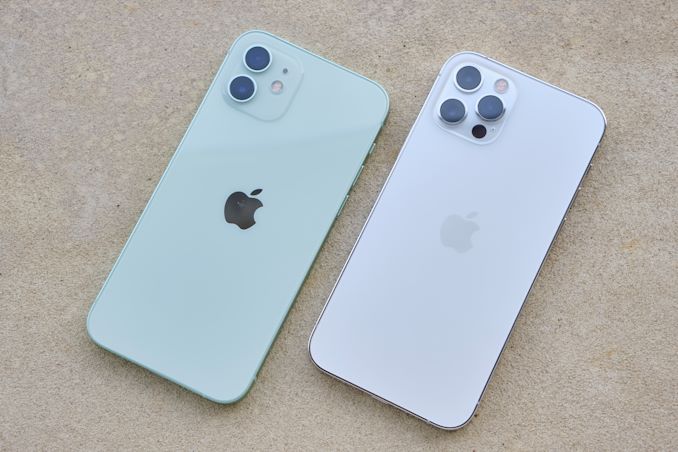
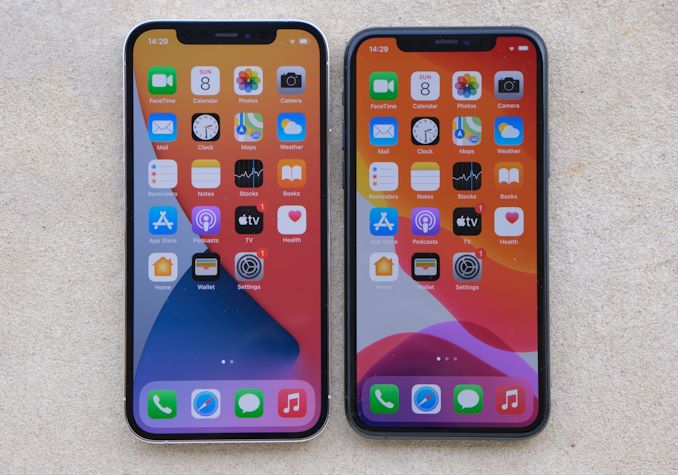
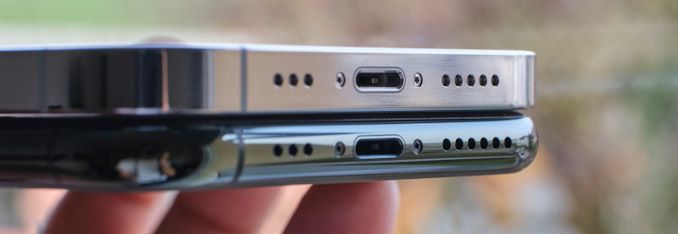

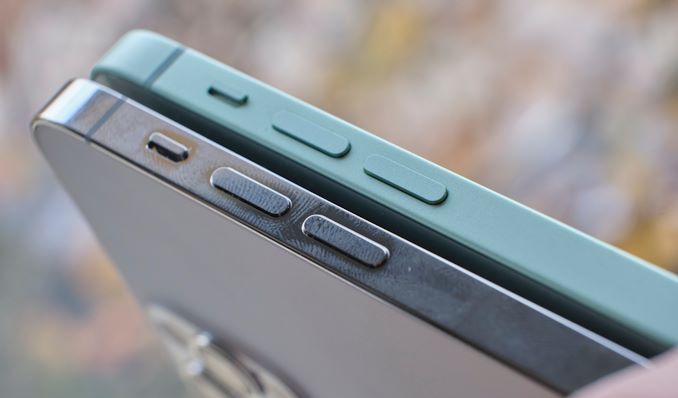
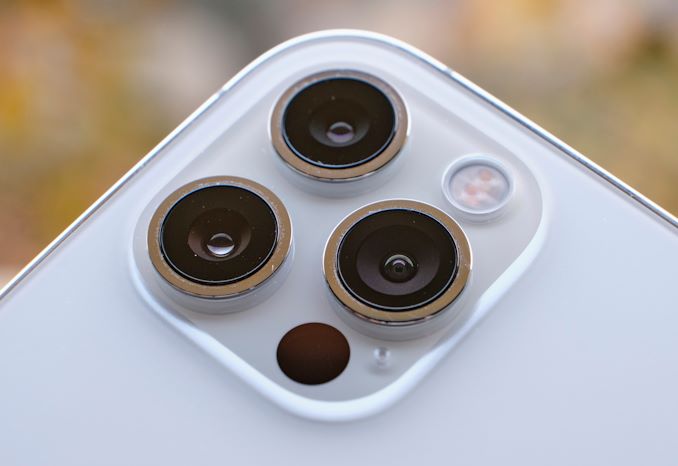








101 Comments
View All Comments
mrvco - Monday, November 30, 2020 - link
It was a good run since the OG iPhone launched, but I seem to have lost all interest in replacing smart phones. I've been using an XS Max (~work phone) and an LG V40 (~personal phone) for two years now and I'm still perfectly satisfied with both devices. They both do what I ask of them with little fuss and there just haven't been any new features or phones that have generated more than a passing interest for me.Bob Todd - Monday, November 30, 2020 - link
As someone who would sometimes change phones more than once a year, I've been in a similar place. We are getting to the point of "good enough" performance. Faster is always better, but high end (and even midrange) SOCs are pretty good these days. My 2 year old phone has 8GB of RAM, 256GB of storage, and a nice large display.I do think this generation of iPhones is interesting for a few reasons though. The Mini doesn't even have a good analogue in the Android world, and I'm excited that premium smaller form factor phones are a thing again.
FunBunny2 - Monday, November 30, 2020 - link
"The Mini doesn't even have a good analogue in the Android world, and I'm excited that premium smaller form factor phones are a thing again."it depends on use case. for those who use a smartphone mostly as a phone, then these Godzilla handsets are contraindicated. OTOH, if the use case is mostly watching video on the run, then the Max and similar make the most sense. Steve clearly intended the former, Mr. Market gave him a full body enema by telling him to shove those teeny, tiny thingees.
KPOM - Monday, November 30, 2020 - link
My mother and sister both opted for the 12 mini since they got tired of big phones. I’m sure they aren’t alone.GC2:CS - Monday, November 30, 2020 - link
Well is there any reason why LPDDR5 was not used over the entire lineup (including M1) ? Is there some hidden compromise with LPDDR5 ?So if CPU is improved quite a bit in regards to efficiency, why the GPU lacks an update ? Is it possible that newer node benefits the CPU more than GPU ?
I heard about new Pro Oleds having better viewing angles. This is something i would greatly appreciate. 11´s Pro do have quite big shifts in white - at screen edges it has greenish, bluish cast. Can somebody describe it a but more ?
I think this generation could be better. But 5G is quite monumental increse in RF complexity and imagining they did it with custom antena designs and thinner designs is quite remarkable.
For exemple three mmWave antenas were discoverd so far. One on the side next to the battery, one behind the motherboard and one under the notch on the front.
But on the other hand 5G sucked up all the effort for other upgrades like better bigger cameras, batteries, 120 Hz and so on.
I refuse to believe that the next one is iPhone 13. That is just so unlucky...
michael2k - Monday, November 30, 2020 - link
I think you answered your own question. The focus on 5G took resources away from lpddr5.mmm200 - Monday, November 30, 2020 - link
I had both X and Xs Max, wife has 11 Pro.I could tell you how good the new 12 Pro Max display is.
It is better than Apple MBP16 in both color and brightness stability! 2 weeks in I'm amazed still how good the Pro display is!
Don't like the oversaturated images made indoor. Just too much vibrance and saturation. Looks unnatural.
2.5x telephoto is great outdoors in sunny weather.
HDR video capture is mindblowing! Using 1080p30 and 1080p60 - looks great on LG OLED!
name99 - Monday, November 30, 2020 - link
It's quite possible that world LPDD5 production capacity was not yet large enough?My GUESS is that the memory controller can handle LPDD5, and the M1X machines will ship with it (and those will be in low enough volume that it's not an issue).
I was surprised that the M1 Macs did not, but presumably Apple concluded it made no engineering sense -- they are clearly fast enough as is, so why not hold something in reserve to make the M1X machines look even better when they ship?
vFunct - Monday, November 30, 2020 - link
Why do you do camera tests without a SINGLE shot of a human being? You know, because how everyone uses phone cameras to take pictures of people at parties and other social events?Are you unable to find anyone willing to have photos taken?
michael2k - Monday, November 30, 2020 - link
Taking pictures of people aren't actually important for the test scenarios:Daylight evaluation is measuring the sensor and software in their ability to balance contrast, dynamic range, shadows, details, and color (and of course there were some people in those pictures)
Low light evaluation is evaluating how well the software can enhance the image without sacrificing color information, creating unusual color casts, capturing details, and balancing the light and darker portions of the pictures.
What you seem to be asking for is a review of https://www.anandtech.com/show/14892/the-apple-iph...">Portrait Mode? The 2018 https://www.anandtech.com/show/13392/the-iphone-xs...">Portrait Mode review was similarly brief (both less than 5 paragraphs!)